Chapter: Civil : Railway Airport Harbour Engineering : Railway Engineering : Curves and Superelevation
Railway Engineering: Superelevation
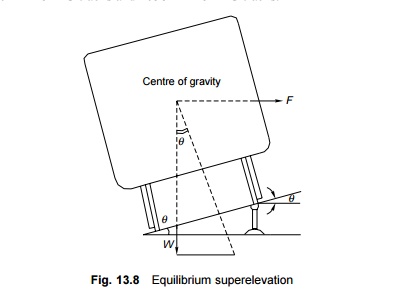
Superelevation
The following terms are frequently used in the design of
horizontal curves.
Superelevation or cant Superelevation
or cant (Ca) is the difference in height between the
outer and the inner rail on a curve. It is provided by gradually lifting the
outer rail above the level of the inner rail. The inner rail is taken as the
reference rail and is normally maintained at its original level. The inner rail
is also known as the gradient rail. The main functions of superelevation
are the following.
(a) To ensure
a better distribution of load on both rails
(b) To reduce
the wear and tear of the rails and rolling stock
(c) To
neutralize the effect of lateral forces
(d) To
provide comfort to passengers
Equilibrium speed When the
speed of a vehicle negotiating a curved track is such that the resultant
force of the weight of the vehicle and of radial acceleration is perpendicular
to the plane of the rails, the vehicle is not subjected to any unbalanced
radial acceleration and is said to be in equilibrium. This particular speed is
called the equilibrium speed. The equilibrium speed, as such, is the speed at
which the effect of the centrifugal force is completely balanced by the cant
provided.
Maximum permissible speed This is
the highest speed permitted to a train on a curve taking into
consideration the radius of curvature, actual cant, cant deficiency, cant
excess, and the length of transition. On cruves where the maximum permissible
speed is less than the maximum sectional speed of the section of the line,
permanent speed restriction becomes necessary.
Cant
deficiency Cant deficiency (Cd) occurs when
a train travels around a curve at a speed higher than the equilibrium
speed. It is the difference between the theoretical cant required for such high
speeds and the actual cant provided.
Cant excess Cant
excess (Ce) occurs when a train travels around a curve at a
speed lower than the equilibrium speed. It is the difference between the
actual cant provided and the theoretical cant required for such a low speed.
Cant gradient and cant deficiency
gradient These indicate the increase or decrease in the cant or
the deficiency of cant in a given length of transition. A gradient of 1 in 1000
means that a cant or a deficiency of cant of 1 mm is attained or lost in every
1000 mm of transition length.
Rate of change of cant or cant
deficiency This is the rate at which cant deficiency increases
while passing over the transition curve, e.g., a rate of 35 mm per second means
that a vehicle will experience a change in cant or a cant deficiency of 35 mm in
each second of travel over the transition when travelling at the maximum
permissible speed.
1 Centrifugal Force on a Curved Track
A vehicle has a tendency to
travel in a straight direction, which is tangential to the curve, even when it
moves on a circular curve. As a result, the vehicle is subjected to a constant
radial acceleration:
Radial
acceleration = g = V2/R
where V is the velocity
(metres per second) and R is the radius of curve (metres). This radial
acceleration produces a centrifugal force which acts in a radial direction away
from the centre. The value of the centrifugal force is given by the formula
Force = mass × acceleration F = m × ( V2/R)
= (W/g)
× ( V2/R)
where F is the centrifugal
force (tonnes), W is the weight of the vehicle (tonnes), V is the
speed (metre/sec), g is the acceleration due to gravity (metre/sec2),
and R is the radius of the curve (metres).
To counteract the effect of the
centrifugal force, the outer rail of the curve is elevated with respect to the
inner rail by an amount equal to the superelevation. A state of
equilibrium is reached when both the wheels exert equal pressure on the rails
and the superelevation is enough to bring the resultant of the centrifugal
force and the force exerted by the weight of the vehicle at right angles to the
plane of the top surface of the rails. In this state of equilibrium, the
difference in the heights of the outer and inner rails of the curve known as equilibrium
superelevation.
2 Equilibrium Superelevation
In Fig.
13.8, if q is the angle that the inclined
plane makes with the horizontal line, then

where e
is the equilibrium superelevation, G is the gauge, V is the
velocity, g is the acceleration due to gravity, and R is the
radius of the curve. In the metric system equilibrium superelevation is given
by the formula

where e
is the superelevation in millimetres, V is the speed in km/h, R
is the radius of the curve in metres, and G is the dynamic gauge in
millimetres, which is equal to the sum of the gauge and the width of the rail
head in millimetres. This is equal to 1750 mm for BG tracks and 1058 mm for MG
tracks.
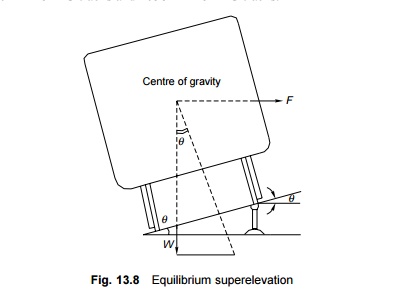
3 Thumb Rules for Calculating
Superelevation in the Field
A field engineer can adopt the
following thumb rules for determining the superelevation of any curve.
(a) Superelevation
for BG in cm

(b) For MG
tracks the value of superelevation is taken as three-fifths of the value
calculated using the preceding formula. The equilibrium speed is used in this
formula.
For
example, if the maximum sanctioned speed (MSS) of the section is 100 km/h, the
equilibrium speed may be taken as 75% of the MSS, i.e., 75 km/h. The
superelevation for a 1 o curve as calculated by the thumb rule is as follows:

Note that presuming that the MSS is 100 km/h, the
thumb rule is that for every 1 o of curve, the cant is approximately 43 mm for
BG tracks and 25 mm for MG tracks.
4 Equilibrium Speed for Providing
Superelevation
The amount of superelevation that
is to be provided on a curve depends not only on the maximum speed of the
fastest train, but also on the average speed of the goods traffic moving on
that section. A compromise, therefore, has to be achieved by providing
superelevation in a way that fast trains run smoothly without causing any
discomfort to the passengers and slow trains run safely without fear of
derailment due to excessive superelevation.
Earlier stipulations
Earlier the equilibrium speed
prescribed on a level track under average conditions was as follows.
(a) Where the
maximum sanctioned speed of the section on both BG and MG tracks was over 50
km/h (30 mile/h), three-fourths of the maximum sanctioned speed of the section
was taken as the equilibrium speed, subject to a choice between minimum speed of
50 km/h (30 mile/h) and the safe speed of the curve, whichever was less.
(b) Where the
maximum sanctioned speed of the section on both BG and MG tracks was 50 km/h
(30 mile/h) or less, the maximum sanctioned speed of the section or the safe
speed of the curve, whichever was less, was taken as the equilibrium speed.
Revised standards
The standards for deriving the
equilibrium speed stated in the preceding section have been revised by Indian
Railways recently. As per the revised standards, the chief engineer (CE) should
decide the equilibrium speed that would be required for the determination of
the cant to be provided on a curve after careful deliberation and taking into
consideration the following factors.
(a) The
maximum permissible speed which can actually be achieved both by fast trains
and by goods trains
(b) Permanent
and temporary speed restrictions
(c) Number of
stoppages
Gradients
Composition of both slow and fast trains
After deciding the equilibrium speed as described, the amount
of superelevation to be provided is calculated using the following formula:

where e is the
superelevation in mm, V is the speed in km/h, G is the dynamic
gauge (1750 mm for BG and 1058 mm for MG tracks), and R is the radius of
the curve in metres.
5 Maximum Value of Superelevation
The maximum value of
superelevation has been laid down based on experiments carried out in Europe on
a standard gauge for the overturning velocity, taking into consideration the
track maintenance standards. The maximum value of the superelevation generally
adopted around many railways around the world is 1/10th to 1/12th of the gauge.
The values of maximum superelevation prescribed on Indian Railways are given in
Table 13.2.
Table 13.2 Maximum value of
superelvation
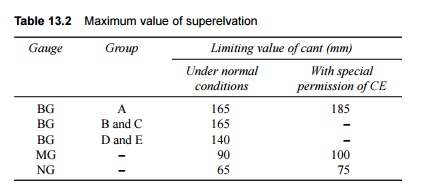
According to Table 13.2, a cant
of 185 mm may be provided for the purpose of setting up permanent structures,
etc. besides curves that have been laid on new construction sites and doublings
on group A routes, which have the potential for allowing an increase in speed
in the future. The transition length should also be provided on the basis of
this cant of 185 mm for the purpose of planning and laying curves.
6 Cant Deficiency and Cant Excess
Cant deficiency is the difference
between the equilibrium cant that is necessary for the maximum permissible
speed on a curve and the actual cant provided. Cant deficiency is limited due
to two considerations:
higher cant deficiency causes greater discomfort to passengers
and
higher cant deficiency leads to
greater unbalanced centrifugal forces, which in turn lead to the requirement of
stonger tracks and fastenings to withstand the resultant greater lateral
forces. The maximum values of cant deficiency prescribed for Indian Railways
are given in Table 13.3.
Table 13.3 Allowable cant
deficiency
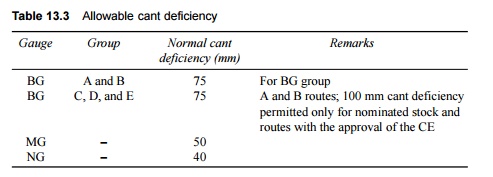
The limiting values of cant
excess have also been prescribed. Cant excess should not be more than 75 mm on
broad gauge and 65 mm on metre gauge for all types of rolling stock. Cant
excess should be worked out taking into consideration the booked speed of the
trains running on a particular section. In the case of a section that carries
predominantly goods traffic, cant excess should be kept low to minimize wear on
the inner rail. Table 13.4 lists the limiting values of the various parameters
that concern a curve.
Table 13.4 Limiting values of
various parameters concerning curves
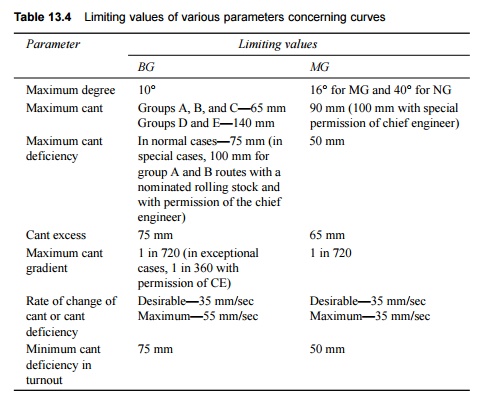
7 Negative Superelevation
When the main line lies on a curve and has a turnout of contrary
flexure leading to a branch line, the superelevation necessary for the average
speed of trains running over the main line curve cannot be provided. In Fig.
13.9, AB, which is the outer rail of the main line curve, must be higher than
CD. For the branch line, however, CF should be higher than AE or point C should
be higher than point A. These two contradictory conditions cannot be met within
one layout. In such cases, the branch line curve has a negative superelevation
and, therefore, speeds on both tracks must be restricted, particularly on the
branch line.

The provision of negative
superelevation for the branch line and the reduction in speed over the main
line can be calculated as follows.
(i)The equilibrium superelevation for the branch line curve is
first calculated using the formula

(ii) The
equilibrium superelevation e is reduced by the permissible cant
deficiency Cd and the resultant superelevation to be
provided is
x = e
- Cd
where, x is the superelevation, e is the
equilibrium superelevation, and Cd is 75 mm for BG and 50 mm
for MG. The value of Cd is generally higher than that of e,
and, therefore, x is normally negative. The branch line thus has a
negative superelevation of x.
(iii)
The maximum permissible speed on the main line,
which has a superelevation of x, is then calculated by adding the
allowable cant deficiency (x + Cd). The safe speed is
also calculated and smaller of the two values is taken as the maximum
permissible speed on the main line curve.
Related Topics